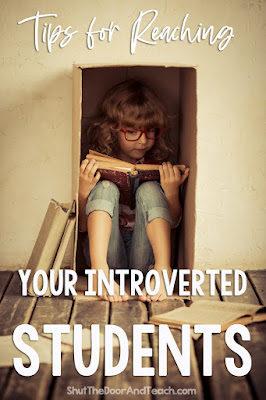What is your ideal working environment for teaching and
learning?
This post is week 4 of 8 in
the 8 Weeks of Summer
Blog Challenge for
educators.” The first few prompts were a bit challenging for me.
I would read the prompts, step away from the
computer, do some cleaning or watch a video, mull it over in the shower,
revisit it the next day, and repeat until the end of the week.
This was not one of those prompts.
I have a LOT
to say about one very specific sticking point.

I can sum up my working style in one word:
Introvert.
The ideal working and learning environment for me is a period of observation
followed by isolated time and space to synthesize and create.
I've known I was an introvert since I first
heard the word in middle school or high school.
But I never really appreciated how misunderstood we introverts can be
until a few years ago.
My principal
encouraged LOTS of collaboration between students.
I changed my teaching style to incorporate
collaboration pretty much at all times (except of course for tests).
And sure enough, I started to feel like the
days were slipping by.
Certain students
who I most closely related to were not performing as well.
Under his direction, I was squashing my
introverts.
And I felt a little lost in
my own classroom.
It started with the desks.
I used to move the desks around often.
Sometimes 3 times per day. For
some activities, I wanted small group work.
Often I'd assign jobs within groups.
Other times we'd be in a circle for a whole class discussion. And yes, there were times that I had the kids
in traditional style rows so they could all quietly focus on their own
work.
He put a stop to that last one.
I knew he was wrong, but at first I went along with it.
Then once I noticed the negative changes in
our learning environment I read
Quiet: The Power of Introverts.
I wrote a blog post about this book because
it changed some things for me.
I knew
that one style isn't better than the other, but I guess I didn't really know
how to communicate it to people who didn't understand.
And my principal REALLY did not
understand.
I think he saw introversion as
something to be remedied.
This book
reassured me that both styles are equally important, and that we all need to
work together at times and do our own thing at times.
So I once I remembered to "Shut the Door and
Teach" I started looking for work arounds.
Although I don't have all the cute little furniture, I took cues from
the "flexible seating" movement to covertly give space to the
introverts. The middle of the room had
the groups he insisted on. During
reading, students could sit at a group with a partner to read together and
discuss the book. But around the
perimeter we had quiet spaces (under tables, spread out in the library, and
tucked into corners) and pillows for independent reading.
During writer's workshop too, I kept the desks in
groups. Even though it felt like madness
to me to have kids talking to each other while trying to write about an
experience outside of school, they were physically side by side. But I circumvented the physical proximity of
groups by walking around saying, "Would you like a shield?" Half the kids said yes. The kids who still complained about others
bothering them were free to choose a table at the side of back of the
room. The kids had freedom to practice
and self assess their work in a quiet space, but if he walked in, he saw the
groups he wanted and he saw a few kids working together which was important to
him.
Math was the trickiest to circumnavigate. Once our district ran out of money for
workbooks and I had created enough games to cover the standards, it was all
group work all the time. The result was
that the stronger students started carrying the lower students, who never had
the time and space to think for themselves.
Finding independent activities during math is my next challenge. Science will be in a year or 2 (since FOSS
uses so much hands on group work).

The group work is great for some kids.
At least half of them, probably more.
However it's so important to make space and
time for the introverts too.
We all need
to learn to work in less than ideal conditions for ourselves.
But no one should have to do it for 6 hours
per day.
Do you find your school
embraces the extroverts like mine?
Do
you have other ways to help out your introverts?
 While my fourth graders were at music, I broke out the masking
tape. I taped 2 horizontal lines and 2
vertical lines on the floor.
While my fourth graders were at music, I broke out the masking
tape. I taped 2 horizontal lines and 2
vertical lines on the floor..jpg) Next, I drew smaller increments on the horizontal lines. Those represent the hundredths.
Next, I drew smaller increments on the horizontal lines. Those represent the hundredths. The activity:
The activity: When the kids walked in after music, they were "floored." They could not WAIT to interact with the tape on the floor!
When the kids walked in after music, they were "floored." They could not WAIT to interact with the tape on the floor! So much fun! And for homework, I made these fraction number line worksheets.
So much fun! And for homework, I made these fraction number line worksheets. 













